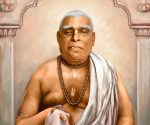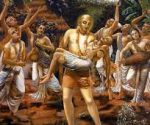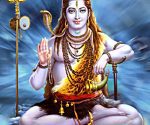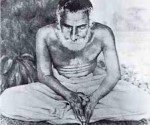The Meaning of Vyasa Puja
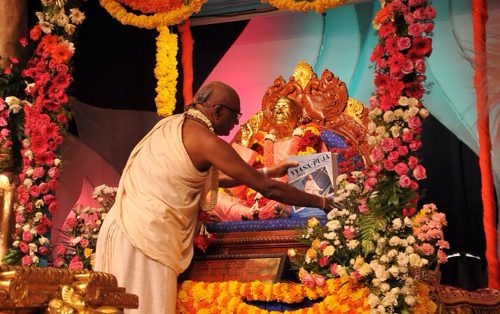 By Kripamoya Das
By Kripamoya Das
Earlier this year, I visited the city of Kolkata and was taken by a kind devotee to an old building on a short backstreet known as Ultadanga Junction Road. I had never been there before, but had heard about the place for forty years. The square, brown brick, rather plain three storey building was formerly known as Bhaktivinoda Asana and it was here, on the flat roof-top, that Srila Prabhupada met his spiritual master for the first time. I had always been intrigued by the idea of a sacred meeting place up on a roof, and it had a special relevance for me, too. In September 1977, Srila Prabhupada came to Bhaktivedanta Manor on what was to be his last visit. I had been sitting close to Srila Prabhupada when, during the Vyasa Puja ceremony, Tamala Krishna Goswami began recounting events from his spiritual master’s early life. He faltered when he couldn’t recall the date of this roof-top meeting. Even though Srila Prabhupada had said nothing until this point, and was in some obvious physical discomfort, he smiled and said “1922” drawing a cheery “Jaya!” from all of us disciples. I was a direct recipient of what had developed since that meeting, and it was because of what transpired on that Kolkata roof-top that I was now sitting before Srila Prabhupada.
The connection of guru and sisya comes after much searching on the part of the disciple and much compassion on the part of God. Srila Prabhupada explained that for the meeting of the disciple with his guru, God Himself makes the arrangements. He said:
“So guru is also incarnation of God, mercy incarnation of God. Guru means that… God is within you, caitya-guru, the guru, or the spiritual master, within your heart. Īśvaraḥ sarva-bhūtānāṁ hṛd-deśe ‘rjuna tiṣṭhati. So this Paramātmā is also incarnation of God. And the same Paramātmā, when He comes before you, being very much merciful upon you, to teach you from outside, that is guru.” (Lecture on SB 1.3.26 October 1, 1976)
“Therefore God is called caitya-guru, the spiritual master within the heart. And the physical spiritual master is God’s mercy. If God sees that you are sincere, He will give you a spiritual master who can give you protection. He will help you from within and without. Without in the physical form of spiritual master, and within as the spiritual master within the heart.” (Conversation on May 23, 1974)
On Vyasa Puja Day we worship Srila Prabhupada as the manifested compassion of the Supreme Lord, and we give thanks for the day he appeared in this world, as well as the blessed day we met him and heard his words for the first time.
* * *
And what are those words? The spiritual master teaches everything we need to know about the Lord who dwells within us, that one supreme person who is unseen by our eyes. As the external manifestation of the Paramatma, the guru teaches the Vedas, the sound manifestation of God. He teaches the Vedas, the Vedanta, the Puranas, and he does it as a messenger of the Lord’s incarnation, Srila Krishna Dvaipayana Vyasa. Srila Vyasadeva is the original spiritual preceptor for all men. And all other preceptors are to be considered his representative.
Only by learning, understanding, living and teaching the Vedas is a person a spiritual master; and only being voiced through the spiritual master can the Vedas become fully manifested and understood in this world. The result of this successful combination – between God, the Vedas, the guru and the disciple – is that the cleansing of the heart takes place; the hard knot of material attraction is loosened; lifetimes of karma-phala are dissolved and the happiness of loving service to the Supreme Lord is established.
The spiritual master is a guru because he is heavy with knowledge and unmovable by any other, lighter arguments. He is an acarya because he moves and lives completely in accordance with the Vedas and teaches the deeper meanings of the scriptures to others. As the Manu Samhita states:
upaniya tu yah sisyam veda-madhyapayed dvijah
sankalpam sa-rahasyam ca tam acaryam pracaksate
One who confers the sacred thread, trains his disciples in sacrifice and teaches them the confidential meaning of the Vedas is known as an acarya, according to saintly authorities. (2.140)
Such a spiritual master is a rare personality indeed, and is someone whose very life contributes the best of all fortune to all those who seek his company. His presence in our life is so valuable because it gives us the greatest possible life: a life lived as a preparation for returning to our eternal home. Through the gifts of knowledge, guidance, encouragement and correction, the spiritual master takes us personally over the darkest valley of repeated birth and death and sets us up in the highest, most glorious place.
When the great Sri Vaishnava poet, Vedanta Deshika (1268-1370) was writing a book about the transmission of spiritual knowledge, he was trying to think of an analogy for the importance of the acarya, the foremost spiritual preceptor, when he remembered something his nephew, Mudaliyantan, had said to him:
“When a lion leaps from one hill to another, the little ants on its body are transported with him. Similarly, when Ramanujacarya leaped over this world of repeated birth and death, we were saved because of our connection with him.”
Srila Prabhupada has similarly leaped over the world of repeated birth and death, and we tiny souls have somehow or other been transported with him.
On Vyasa Puja Day we try to understand our incalculable good fortune of being connected with such an acarya as Srila Prabhupada. He not only carried the message of Srila Vyasadeva but showed us how to live it. He continues to personally lead us from this world of darkness to the world of eternal light. We give thanks for his boundless compassion and never-ending efforts to save us, and we think that through him, we have come to understand the meaning of the term ‘His Divine Grace’.
* * *
‘The juiciest, sweetest mango is always in the sunshine at the very top of the tree.’ Thereby begins the classic analogy of how the highest spiritual teachings are brought down from ancient times to today. A chain of ‘fruit-pickers,’ sitting in the branches of the mango tree, carefully hand down the delicate fruit from higher to lower branches until it reaches the ground. Similarly, the compassionate preceptors always ensure that the teachings are handed down to the next generations. Yet it is no easy task, and even Lord Krishna says that He must come to the Earth, age after age, to re-establish the teachings that have been lost. One essential component of preserving the living message is therefore the chain of teachers – the parampara.
The greatest spiritual master is moved by compassion to make the teachings of the Vedas accessible to as many as possible. Without compromising their integrity he renders them intelligible and accessible to contemporary listeners, protects them from adulteration, and preserves them by creating the next generation of teachers. Srila Vyasa codified, compiled and protected the entire Vedas and is therefore known forever as the ‘literary incarnation of God.’ The Srimad Bhagavatam provides a description of how the sage divided the responsibility for the preservation and extension of Vedic knowledge:
“Paila Rsi became the professor of the Rg Veda, Jaimini the professor of the Sama Veda, Vaisampayana protected the Yajur Veda, and Angira Muni the Atharva Veda. Romaharsana Suta was entrusted with the Puranas and historical records.” (1.4.21-22)
The illustrious son of Romaharsana Suta, the grand-disciple of Srila Vyasadeva, Suta Goswami, then assumed responsibility for protecting the Puranas.
Without teaching his disciples, empowering them to become advanced in spiritual practise and also engaging them in teaching and preaching, the acarya’s work is not complete. Only when he has safeguarded the message of the Vedas for the next generation – both in precept and example – can he be satisfied that he has offered the world what his own preceptor offered him. As the Vayu Purana explains:
Acinoti hi sastrarthan acare sthapayatyapi
svayam acarate yasmad acarya stena kirtitah
“The acarya is thus called because he has studied and understood the meaning of the scriptures, he practises what he preaches, and he establishes this meaning in the behaviour of others.”
The spiritual master not only comes in parampara, but he ensures that the parampara continues by making the Vedas accessible and intelligible, the essential spiritual techniques practicable, and by fully initiating and training his disciples. He encourages his students to do the same for their countrymen and the next generation. In this way the ancient knowledge and tradition is preserved yet always kept fresh. Thus the sacred mango gets passed down the tree to the next level and to the human society that is yet to come.
On Vyasa Puja Day we honour Srila Prabhupada as one who preserved Vedic knowledge and made it accessible to a fresh, new audience. We honour him as one who explained the deeper meanings of the scriptures and demonstrated by his example the efficacy of the spiritual techniques described in them. We honour him as one who walked through the Earth establishing the sacred arca-vigraha, restoring brahminical culture and arguing for cow protection – the hallmarks of civilized human life. We give thanks that he initiated and trained many disciples to carry forward his messages and preserve the chain of teachers.
* * *
On February 5th, 1919, just three years before Srila Prabhupada met him, Srila Bhaktisiddhanta Saraswati Thakur performed one more duty of an acarya. He gave a human and organisational shape to the mission to perpetuate the parampara. Although the parampara will continue to exist whenever and wherever there is teaching of the Vedas, training and mantra-giving, it is such a delicate structure that sometimes it may not even be located by those who are any less than supremely dedicated. When an organised mission is established there can be greater strength. When disciples gather into groups, each with a specific task, the mission to serve the predecessor gurus can be done with improved efficacy. Yes, there is always danger that the power so accrued by such an efficient organisation may turn the heads of even the most devoted disciple, but done well and with devotion to the spiritual master, it will serve his purposes well.
The Six Goswamis of Vrindavan had similarly organised themselves and their followers and called their assembly the Visva Vaisnava Raja Sabha. Srila Bhaktivinode Thakur had also revived the mission of the Goswamis as a human organisation. In 1919 Srila Saraswati Thakur gave a human shape to what he described as the ‘third descent’ of the Visva Vaisnava Raja Sabha. Speaking at the property known as ‘Bhaktivinode Asana’ at Ultadanga Junction Road in Calcutta, before a large assembly of Vaishnavas, he said:
“Even though this Sabha is eternally established, it has descended into the world three times. Eleven years after the disappearance of Shri Mahaprabhu, when the world was beginning to darken, six wonderfully bright stars arose in Sri Vraja-mandala and were engaged in the service of Gaurachandra…
“Sri Chaitanyadeva is Krishnachandra Himself—the King of all the Vaisnavas in the world (Visva Vaisnava Raja). The gathering of His devotees is the Sri Visva Vaisnava Raja Sabha; the foremost ministers amongst the members of the society are Sri Rupa Gosvami and his honoured Sri Sanatana Gosvami. Those who consider themselves to be the followers of Sri Rupa are the members of this Sri Visva Vaisnava Raja Sabha.”
A guru lives to give systematic knowledge, relevant guidance and inspirational encouragement to all who wish to receive it from him and who are qualified to become disciples. He gives whatever he has with compassion, love and discipline, and he sets before his grateful receivers a living example of what it means to be in consciousness of God and His laws. To better share his gifts with others, the guru invites them to come and live with him.
Yet the guru’s mission is also to broadcast and propagate the teachings to as many newcomers as possible. Even to those who cannot live with him. That enormous task requires the training of future travelling teachers, preparation of various types of publications, and the building of temples and other venues so that people can congregate and become educated and inspired, no matter what their level of spirituality or commitment and no matter where they live. It involves organising groups and devotee farms and villages so that future would-be disciples can be part of a social network and helped toward discipleship. Existing disciples and their families can also live peacefully and be supported through the inevitable challenges of life. The disciple’s role in all this is to help the guru and to alleviate his burden. When this larger mission of the guru is understood by the disciple, he or she will participate in the mission of the guru by offering energy, time, intelligence and resources.
It is a privilege to be even a small part of such a glorious movement for the spiritualisation of human society. Although to mundane vision ISKCON may be perceived as merely a human institution, with transcendental vision it can be seen as a compassionate vehicle of Srila Prabhupada’s divine grace, the most important institution in the world, and an excellent means to accomplish the complete manifestation of the desire of the Six Goswamis.
Vyasa Puja is an opportunity for all of us gathered here today to reflect upon the mission and movement of His Divine Grace A.C. Bhaktivedanta Swami Prabhupada. It is a movement of inspired devotees of Krishna, established to make tangible the hopes of all the predecessor acaryas. It began on a suburban Kolkata roof-top in 1922 with a simple instruction to teach the message of the Vedas in the English language. Our appreciation for everything we have received from Srila Prabhupada, of how it has transformed our life, and our display of gratitude, must surely be to continue the mission and message of this most extraordinary of all representatives of Srila Vyasadeva. May we honour him today and always, and work together to share him with the world.




